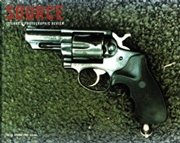Family Photographs
'Shades of Time' by Annalies Strba was at Douglas Hyde Gallery in January 1999 / Lars Müller Publishers £35
Review by Maeve O'Sullivan
Issue 18 Spring 1999
View Contents ▸
'Shades of Time' is a photographic installation by the Swiss photographer Annalies Strba. Three projectors simultaneously show slides (240 in total) which change every 11 seconds, with accompanying electronic, percussion-based music. There are bell-like sounds and others simulating the noise of wind blowing. The music does not intrude, but neither does it add very much other than providing an ambient atmosphere. The work is also reproduced in a book.
As the title suggests, the show covers a period of time in the photographer's life spanning twenty years or so. During this time she took numerous photographs of her family at home, plus many others while travelling in England, Japan and elsewhere. The photos are shown for the most part in chronological order, the majority of them depicting Strba's family, i.e. her husband, her two daughters, her son and, later, her grandson. The setting is usually the family home. The earlier images are predominantly black and white photographs of her children. The viewer is drawn into the intimacy of their everyday activities - sleeping, playing, and eating. There is one charming picture of her son Samuel in the bath, wrestling with the family cat. The cat looks straight at the camera and the spectator with luminous eyes. Samuel with Ashi 1979
Samuel with Ashi 1979
Gradually colour is introduced and we see the children getting bigger, dressing up, exploring their lives, and becoming more aware of the camera. We also observe how technical colour processes themselves have changed during the last two decades.
The device of showing the photographs in sequence counterbalances the fact that each one captures only one moment in time. We are lulled into a home movie type mentality where we can watch these moments of time passing in the life of a family. The main disadvantage of this type of installation is that the absence of titles leads to a lack of clarity about the images, their place in the chronology and their context.
Strba's portrayal of domestic life and her documentation of the growing up process is engaging in an immediate way. It is also a little unsettling, since the spectators are privy to the private scenes of a family with whom they are not acquainted. Although this doesn't lapse into voyeurism, one does have the sense that one has intruded in some way, got lost among the apartment blocks of urban Switzerland, and stumbled into their apartment by mistake. Linda with Omar 1994, original in colour
Linda with Omar 1994, original in colour
Unlike a fly-on-the-wall documentary, the photographer here is a member of the family, and imbues the images with a more loaded energy. This has some parallels with the work of Sally Mann, although their styles are very different. Mann's work can also be uncomfortable but not always for the same reasons. The controversial portraits of her children posing, naked in many cases, has a disquieting effect on many viewers.
For this viewer, however, Mann's images are ultimately more satisfying than Strba's, whose photographs are compositionally less aesthetic and technically less 'restrained'. One of the exceptions to this is a captivating depiction of Strba's daughter Linda and her friend Omar, both asleep in the back of a car, arms entwined.
In her travels, Strba seems to be drawn to places that have experienced tragedy or catastrophe of some kind. She visits Kobe after the earthquake and takes photos of buildings in various stages of collapse. We see groups of schoolgirls smiling shyly into the camera at Hiroshima. She even takes photos of Chernobyl from the television. I'm not clear about the somewhat apocalyptic message of these images, if indeed there is one, or their juxtaposition with portraits of family members. I think Strba is trying to achieve too much in this show, with the outcome of confusing the viewer by the multiplicity of images. Once again the lack of titles or explanatory notes adds to this confusion.






